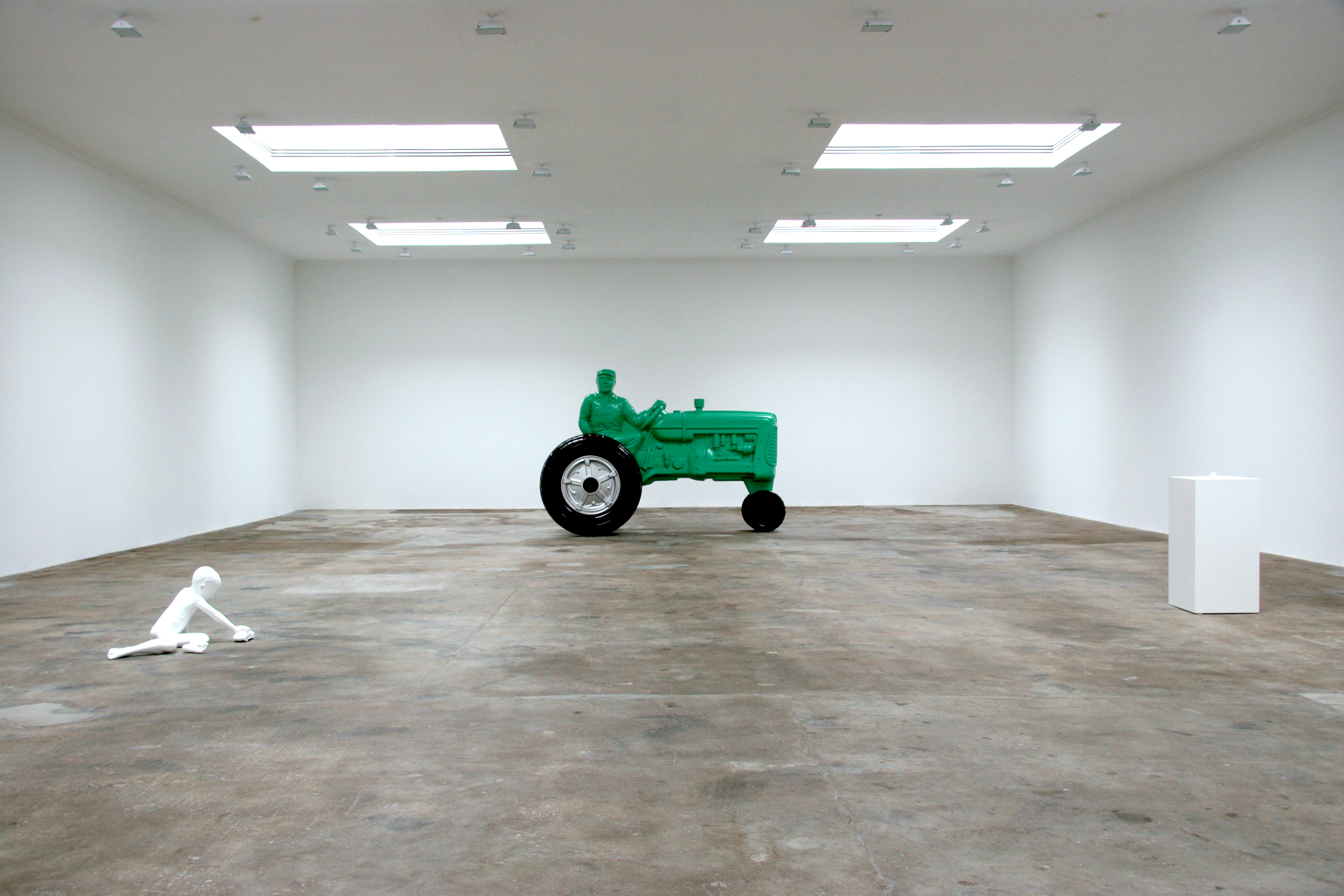Whitehot Magazine
December 2025
"The Best Art In The World"
"The Best Art In The World"
December 2025
January 2008, Charles Ray, Matthew Marks Gallery

Charles Ray: Chicken, The New Beetle, Father Figure, installation view. Matthew Marks Gallery, New York,
November 14, 2007 through January 19, 2008 Copyright Charles Ray,
courtesy Matthew Marks Gallery, New York.
Charles Ray at Matthew Marks Gallery, 522 West 22nd Street,
New York, NY 10011
www.matthewmarks.com
November 14, 2007 – January 19, 2008
Charles Ray has produced three new sculptures for his exhibition at Matthew Marks gallery on 22nd Street. This is his first solo exhibition in New York since his 1998 retrospective at the Whitney Museum of American Art. Entering the gallery I am greeted by the image of a larger-than-life, slightly distorted, green, male figure on a green tractor with black tires at the opposite side of the gallery from the door. On the right side of the gallery is a pedestal with a small object on the top. And to the left there is a white, nude figure of what appears to be a pre-adolescent boy. Ray’s new sculptures are cold, silent, and eerie. They present strong, immediate images with a challenge to read. The deliberate shift in scale between these three sculptures is veiled behind the impeccable craft in the production and painting of these works, but it is the shift in scale which is the cause for viewers to consider their own role in the room.
Approaching the figure on the tractor, Father Figure, I am struck by its enormity, coupled with the figure’s uncanny, green, presence. The work appears to be solid, painted plastic. The figure’s legs mount the tractor, while its torso and face are turned 90 degrees towards the entry of the gallery, away from the front of the tractor. The sculpture conjures something familiar and I learn from the press release that it was inspired by an old plastic toy and that it is eighteen and a half tons of painted, solid, machined steel. The sculpture is a laborious representation of a toy, designed for a child’s leisure, which represents the labor of agriculture. The labor involved in producing this work is not evident in its presentation, apart from the information in the press release. The looming scale of this work, and its title Father Figure, suggests a solemn value of labor inscribed onto children in early development. The sculpture rises up above adult viewers as a real man on a tractor might rise above the child who plays with the toy it represents.
Turning away from Father Figure, I move towards The New Beetle, a white-painted stainless steel sculpture of a nude, pre-adolescent boy, sitting on his side playing with a hand-sized, new model VW Beetle. Standing over this sculpture of a boy with his small- scaled car, causes me to reflect on my own scale, in between Father Figure and this one. The boy is engaged in the leisurely activity of playing with a toy car, which is in turn a representation of a model designed for a more leisurely lifestyle than one of labor. While the child is engaged in an act of leisure, I wonder if this leisurely activity is a type of labor. He is doing that which a child is supposed to be doing; he is playing, doing what is proper for a child to do. Much like it is proper for a grown man to drive a tractor and plow a field or tow a wagon.
Across the gallery from The New Beetle is a pedestal with a small object on top. Approaching the pedestal I learn the object is an egg, and looking closer I see the very detailed porcelain cast of a baby chicken through a perfectly round one-inch hole. The egg is machined, painted stainless steel. This sculpture, titled Chicken, is a depiction of a baby chicken performing the labor of its own labor; its struggle from the darkness of incubation into the light of life. Leaning in closer in an attempt to get a better look, I sense the gallery attendant’s discomfort through his shift in position, and I back off.
Each sculpture maintains such a strong presence, stands in stark contrast to the other sculptures, especially regarding scale, and in contrast to the scale of the viewer. Being in the room with these works is subtly unsettling. The effect causes me to consider my role as a viewer in relation to these sculptures, which all represent some manifestation of labor. The absence of a visual record of the labor involved in producing these works is mirrored by the viewer’s act of looking – the activity which appears at first to be one of leisure, is actually an act of labor.

Chris Kasper
Chris Kasper is an artist/teacher/writer living in New York City.
He holds an MFA from the School of Art at Yale University and completed the Independent Study Program of the Whitney Museum of American Art in 2006.
ckasper13@yahoo.com








